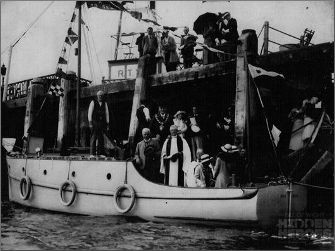Charles Paterson was a keen photographer and a gifted amateur painter. Remarkably, he also kept a log of the work that might otherwise have gone largely unnoticed.
The Rev. Charles Paterson was Vicar of Holy Trinity Church in Cowes and Hon. Chaplain to the Royal Yacht Squadron. In addition to these duties, he was Hon. Chaplain to the Missions to Seamen, in charge of their very active branch in Cowes.
On 30th July 1936 he conducted the dedication service for a new launch for the Mission, the Nai Louis, a boat donated by a lady who lived in a house overlooking Wootton Creek.
Mrs Leonowens’ late husband, Louis, after whom the boat was named, was the son of Anna Leonowens, one-time governess to the children of the King of Siam, and immortalised in the musical The King and I. (Nai being Siamese for ‘Master’).
A variety of talents
Charles Paterson lived in the Vicarage on Cowes Esplanade, opposite his Church, and was a keen photographer and a gifted amateur painter. Remarkably he also kept a log of the work that might otherwise have gone largely unnoticed.
When the Second World War began, there came to anchor in Cowes Roads a vastly increased number of ships of all sizes, awaiting orders, waiting to be assigned to convoys before setting out on the dangerous sea routes patrolled by enemy submarines.
The County Press of February 1946 reported that, for security reasons, a veil of secrecy was drawn over the activities of the Mission throughout the war, but several times a week, promptly at 9.30, Charles Paterson would go aboard the Nai Louis which had been brought round from its moorings in Wootton by her skipper, Capt. William Brooker of Ryde, and, with a third crew member, they would set out in all weathers to visit three, four, five ships a day.
Visiting all
If it was sometimes too rough or too foggy for the Vicar to board the ships safely, Capt. Booker would steer up the River Medina to visit the many ships and boats sheltering there.
They also paid regular visits to the Trinity House lightships at Calshot, and the Warner, which was off station, having had been brought inside the submarine barriers in Spithead.
Meticulous record-keeping
They took with them all manner of comforts for the ships’ captains and crews, books, magazines, warm clothing, cigarettes. Charles Paterson kept a list of the donors of all these welcome supplies and although a number of names were of local people, many addresses were on the mainland.
He also took photographs, almost certainly against wartime regulations, and painted small portraits of many of the ships he visited.
Link to the outside world
Charles Paterson, very much no longer a young man, had to climb up steep ships’ ladders, often icy and always wet, in order to deliver these gifts and to take back ashore everything the crew needed help with, mostly letters to post and telegrams to send to relatives, cards, messages and often farewells for family and friends.
None of the crew were able to get ashore themselves, so this small 35 ft. launch and its complement of elderly men was often their only contact with home and the wider world.
Many letters were received expressing the gratitude of the crews for the work of Rev. Paterson and his friends, who heroically kept this service to seamen afloat throughout six long years of War.
Find out more
You can find out more about Charles Paterson at the Classic Boat Museum
Share
Facebook
Twitter
Find out more
You can find out more about Charles Paterson at the Classic Boat Museum
Other info and photos

© Classic Boat Museum

